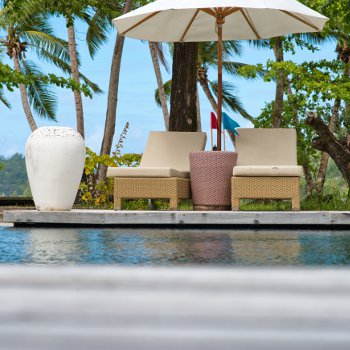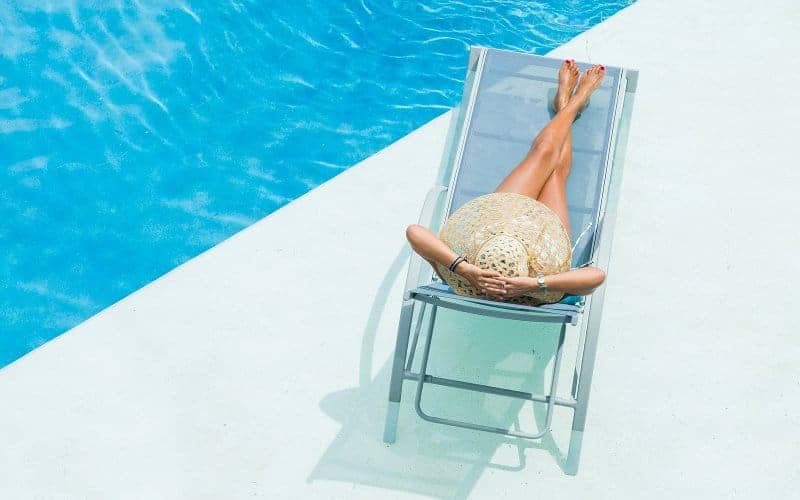
What could be better than relaxing by the pool on a hot summer day? Relaxing in the pool, of course. And what could be better than that? Relaxing in the pool in the shade.
If you agree with that line of thinking, then you understand the appeal of in-pool umbrellas. Unlike freestanding umbrellas that sit on the pool deck, an in-pool umbrella is mounted in a sleeve in the pool itself. It’s a fantastic addition to a beach entry or baja shelf, where a little shade keeps the shallow water cool and refreshing on sunny days.
In fact, depending on the type of inground pool you’re looking at and how you plan to use it, having a built-in umbrella holder could be a no-brainer. However, we recommend using your brain anyway. You’ll need it to weigh the pluses and minuses of this increasingly popular pool feature.
Pros and Cons
The main advantage of in-pool umbrellas is that they reliably throw shade directly over a swimming pool, something that can be difficult or awkward to do with other options. Another huge selling point is the fact that they look so sharp. You’d be hard-pressed to find a pool feature at a similar price point that adds the same sense of style and luxury.
The main downside is that in-pool umbrellas don’t fit just any pool design. You typically need a concrete pool with a beach entry, baja shelf, large pool steps, a bench, or some other sort of ledge where you can sit and relax under the umbrella. While you could technically install an umbrella sleeve in deeper water and use a poll extender to get the umbrella to the right height, it would be unwieldy and there are probably better options.
Also, while in-pool umbrellas are cheap when compared to other pool features, they’re obviously more expensive than using freestanding umbrellas around the pool. Besides the cost to have the sleeve installed, you’ll need a higher quality umbrella made of stainless steel, fiberglass, or aluminum that can hold up in the water. Wooden umbrellas in particular should be avoided, as the water will cause them to swell up and get permanently stuck in the sleeve.
Do You Need an In-Pool Umbrella?
An in-pool umbrella deserves strong consideration if you have a beach entry or baja shelf. Otherwise, it just depends on whether you have a good spot to install the sleeve and a desire to spend a lot of time lounging in the water. Before deciding, make sure you look closely at other shade options, including:
Freestanding Umbrellas. Standard patio umbrellas can be moved around wherever you need them, and may even be able to throw some shade over the pool. As mentioned, they have the advantage of being cheaper and easier to set up than in-pool umbrellas.

Offset Umbrellas. Also known as cantilever umbrellas, these types of umbrellas feature canopies that can lean out over a pool. The base can either be freestanding or a sleeve installed in the pool deck.
Shade Sails. This type of covering stretches over the water from polls anchored around the pool. Like in-pool umbrellas, shade sails are known for their striking appearance, although they can also obscure your view of the pool.
If you decide on an in-pool umbrella, the ideal time to add it is when the pool is first built. However, you can also install an umbrella sleeve to an existing pool as a modest renovation project. One advantage of adding the sleeve later is that it gives you a chance to see where the sun falls on your pool – and thus, where the shade is most needed.
To sum up, the appeal of having an umbrella in your swimming pool is pretty obvious. But where to put it might not be. Provided you have a good spot for an in-pool umbrella, the only question is whether you can find a better option than this for shading your pool.


